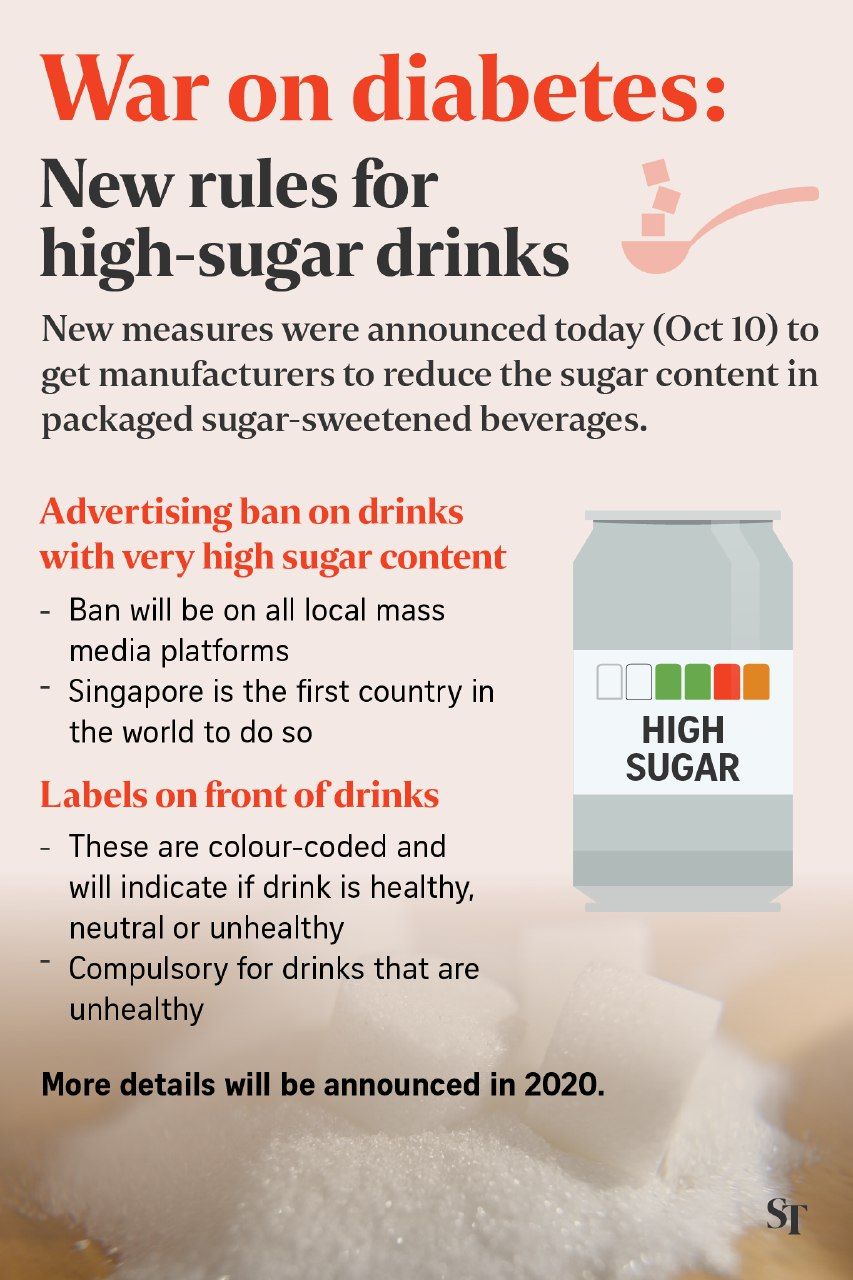
SINGAPORE — The war on diabetes continues with a total ban on advertisements of packaged drinks with very high sugar content – making Singapore the first country in the world to do so.
Such drinks as well as medium-to-high sugar content drinks must also carry a label on the front of the pack to signal that it is unhealthy.
Drinks affected include those in bottles, cans and packs. It covers two- or three-in-one instant drinks, soft drinks, juices and cultured milk and yoghurt drinks.
When this comes into play and what exactly will be affected will be announced in 2020.
Announcing this on Thursday (Oct 10), Senior Minister of State for Health Edwin Tong said these changes are designed to encourage people to make more informed choices and to get manufacturers to reduce the sugar content in packaged sugar-sweetened beverages, or SSBs.
The front-of-pack label will be colour-coded and show a grade to indicate if the drink is healthy, neutral or unhealthy. More than 30 countries have introduced such labels, with great success. In Chile, for example, the sales of drinks carrying the unhealthy label fell by 25 per cent after 1½ years.
The amount of sugar will be a large but not the sole determinant of the grade a drink gets. Other factors include the amount of saturated fat such as that found in three-in-one coffee mixes.
The label will be compulsory only for drinks classified as unhealthy. But healthier drinks may use the label as promotion.
Speaking at the Singapore Health & Biomedical Congress at Max Atria, Mr Tong said manufacturers of healthier drinks are encouraged to use the label “to aid in consumer decision-making”.
He added: “Under the new nutrient summary label, healthier SSBs can receive a positive grade, and we leave it as an option for the manufacturers whether or not they want their products to bear the label.”
The move is part of the war on diabetes, which is a major health problem in Singapore. A survey in 2018 found that more than half the 12 teaspoons of sugar people consume here daily come from sweet drinks.
Said Mr Tong: “This is a concern, as drinking an additional 250ml serving of SSBs every day increases the risk of diabetes by up to 26 per cent.”
In spite of exhortations to reduce sugar content, makers of medium-to-high sugar drinks have not reduced the average of five teaspoons per 250ml in the past decade. Some have as many as eight teaspoons of sugar per 250ml.
These high-sugar drinks are popular, accounting for half of all SSBs sold here.
In December last year, the Health Ministry and the Health Promotion Board (HPB) started eight weeks of public consultation on how to reduce sugar intake here.
It had proposed four possible measures: mandatory front-of-pack label, regulation on advertising, a sugar tax, and ban of high-sugar SSBs.
The use of a compulsory label received the highest support, with 84 per cent of the more than 4,000 respondents in favour of it.
Less than half favoured a ban on such drinks, saying “it was too extreme and deprived consumers of their ability to choose”.
Although only two of the proposed actions are being implemented, the other two options are still on the table.
Said Mr Tong: “We will need more time to study these, and will continue to explore an excise duty or a ban on higher-sugar SSBs.”
During the consultations, the drinks industry was strongly against a tax or ban of high-sugar drinks, claiming that the two moves would not reduce sugar consumption.
Besides the four measures discussed, others proposed included regulating freshly prepared drinks and sugary foods.
The MOH said: “There were concerns that sugar intake from these (freshly prepared) drinks would increase, and consumers might simply substitute one source of sugar for the other.”
Other suggestions that emerged from the consultation was the need to strengthen educational efforts and to make water more easily available, including having it offered free in restaurants.
Professor Yik Ying Teo, dean of the National University of Singapore Saw Swee Hock School of Public Health, hailed the move as “a step in the right direction”.
He added: “Definitely at the same time, there needs to be a concerted public education campaign, one that builds upon family and role models as the drivers for health-seeking behaviors.
“Children’s tastebuds are very much reflecting what parents themselves take, and a campaign that targets the family as the unit rather than specific segments – like schools for children, workplace for adults – may have long-term returns.”
He is also glad that the MOH has not given up on a possible sugar tax. He said: “There is evidence from countries which have implemented the sugar tax that it works to discourage consumption, encourage innovation and reformulation, and raise awareness of harmful effects of excessive and unnecessary sugar consumption.”












































